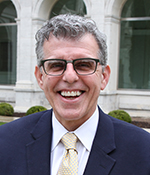April 2017

David Gozal, MD, MBA
“The greatest misery of sickness is solitude.” –John Donne, English poet
The dilemma of illness and isolation can be difficult to confront. A large body of work by John Cacioppo and others on the hidden effects of loneliness in almost every aspect of cognitive functioning has provided us with compelling reasons to alleviate loneliness and empower coping and resilience. Loneliness is a challenge we should be able to tackle, and one that we can approach on multiple levels. The first and perhaps most important of these tactics begins from within.
Our Perspectives as Physicians
If you haven’t read the book When Breathe Becomes Air, which has been a bestseller since its release in early 2016, I highly recommend it.
It is a resource that in my opinion grants us access to the patient’s inner world. This memoir captures Paul Kalanithi’s diagnosis with a rare incurable lung cancer, and follows the reflections of his life and approaching death. He dies at 37, and we bear witness to his most treasured memories, deepest worries, and sincerest concerns.
What makes the tale unique and carry more meaning for us is that the author is a fellow physician (a neurosurgeon in training). Dr. Kalanithi acts as a “dual citizen,” and since he is at once patient and provider, his story simultaneously instructs us on how we can be better doctors and raise our quality of the care.
In the rush for the latest technological innovations and scientific advances, sometimes the more human aspects of medicine are overlooked. Never has our time been as efficient, and calculated, and in so much competition with the growing demands of our busy schedules.
In pausing to take in Dr. Kalanithi’s story, we inhabit the patient’s shoes, if only for a moment. We imagine what we would do in similar circumstances. We become more aware of pain in the face of death and uncertainty. We sense helplessness and react with greater sensitivity to other’s needs. The tale transforms us, and through our new understanding we can better accompany our patients on journeys of illness and wellbeing.
Roles of Families and Fellow Patients
In some ways, the role of families is already built into pediatric practice, as my colleagues and I who treat children view our patients in the context of their caretakers.
Serious illness often requires offering as much support to the family, as to the patient. The Veterans Health Administration, as one example, has resources for caregivers on its website. Equipping family members with tools to manage their loved one’s illness—including the lesson of self-care—is vital.
Outside of the home and family, patient communities deliver a variety of resources for patients. Some of these support groups are also open to family members.
With rare diseases, in particular, connecting to individuals that share your condition is life-changing. A frequent theme, in fact, for our Public Advisory Roundtable publications, the Patient Voices series, is the beacon of hope patients feel when they discover and connect with their patient communities and support networks for the first time.
Let us not forget that we as clinicians have the unique privilege of not only managing disease but also of being there for our patients in their times of need. We should always act with supporting and caring hands, especially when our patients feel lonely. Every time you enter the room where your patient is, just think, What can you do to make your patients feel more supported and less alone?
Living with a disease does not mean having to face the disease on your own.

